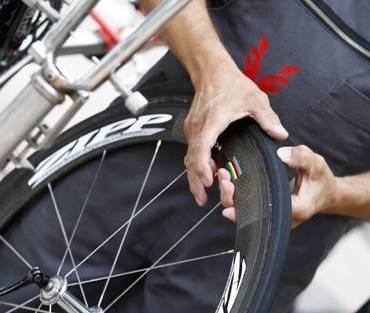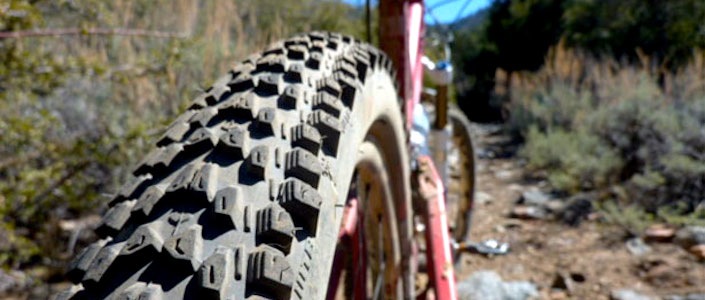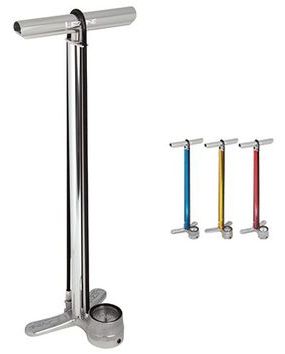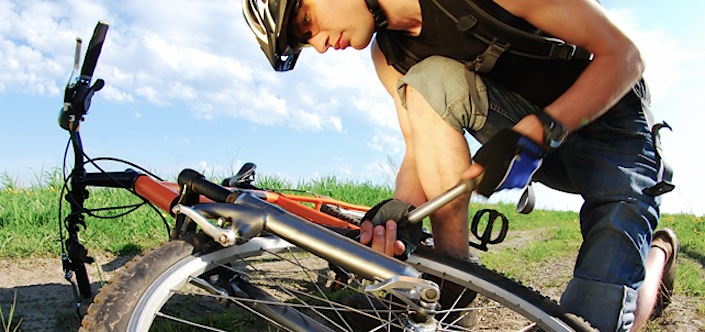Everybody has their own opinion on tire pressure. There are so many parameters to take into account when finding your optimum tire pressure that it would almost be impossible to know exactly what to run. All road and off-road tires have their upper and lower pressure ranges printed onto the sidewall, but the range of choice within their specified pressures is still enough to leave you perplexed: "Which pressure is right for me?!"
TIRE PRESSURE - THE WRONG WAY
If you want to do this the wrong way, just pump your tires up to the suggested maximum pressure printed on the sidewall and ride your bike. You'll enjoy a most unpleasant and rough ride, less cornering grip and the potential to deform your rim wall until the tire bursts off the rim. The other benefit of doing this the wrong way is that your braking will heat the rim up and increase the already maximum tire pressure - this could result in an exploding tire and a very dramatic dismount from the bike.
By having your tires inflated too firmly you also reduce the tire's ability to comply with the road surface. Instead of the tire deforming and absorbing imperfections in the riding surface, it will vibrate and buck its way along, transferring all that vertical energy into your body and dramatically reducing grip.
We strongly suggest you avoid doing this the wrong way, but instead try doing it the right way!
TIRE PRESSURE - THE RIGHT WAY
Consider this little fact first, and then read on: A properly inflated road tire at 85 PSI has nearly the same rolling resistance as a tire inflated to 115 PSI. Rider weight has a very marginal effect on this piece of information. That means you could reduce your tire pressure to 85-90 PSI and experience a smoother ride with better cornering grip and better tire wear - all while not even increasing your rolling resistance!

Photo: Road Bike Action
To inflate your tires correctly, you may also want to choose different pressures for the front and rear tires. After all, most of your body weight is distributed over the rear wheel. Experiment to see what feels best for you, but we can recommend starting with the following pressures.
| FRONT TIRE: | 80 - 85 PSI | 80 PSI |
| REAR TIRE: | 85 - 90 PSI | 85 PSI |
NOTE: Despite this, many road cyclists just love the feeling of the perceived advantage of running 100+ PSI. If this is you then stick with it, but why not give running a slightly lower pressure a try - it may make that century ride a little easier to survive.
When it comes to punctures, you're at no greater risk riding at lower pressures - unless you're on a MTB and you happen to pinch flat. Which brings us to our off-road riding fraternity...
MTB TIRE PRESSURES

This conversation is enough to start a war, but hopefully we can shed some light on the subject. Mountain Bike (MTB) tires offer a whole new world of choices compared to road bike options. From hardpack tires, through to loose surfaced gravel and finally mud. But when it comes to tire pressures, you need to consider quite a bit more than your road riding buddies!
There are also different recommended pressures for tubeless MTB tires, and even different wheel sizes and their subsequent recommended pressures. We'll summarise this to keep it simple, but please ask us any other questions in the comments below if you feel the need.
Normal MTB Tires
This refers to a tire with a tube in it. When mountain bike riding, you are at a greater risk of pinching this tube by hitting a sharp object on the trail. This can result in a flat tyre, but can be avoided. Pump your MTB tires up to around 30-35 PSI to avoid this issue without sacrificing too much grip. If you still pinch flat, consider your riding style and try to avoid slamming into sharp edges when riding.
Tubeless MTB Tires
If you are running a tubeless MTB tire system you probably wish you did it a whole lot sooner! Less flat tires, lower tire pressures and better grip! When it comes to choosing your tire pressures on a tubeless system, don't be afraid to try lowering your pressures a bit more. Try riding 28-32 PSI on your next ride as a starting point. If you're running particularly wide tires, your tyre will balloon outwards, and offer a larger contact patch with the ground. This offers a smoother ride in most cases, but is also another topic altogether!

The best way to discover what works best for you, both on road and off-road, is to talk to other riders and see what they prefer. From there you can then consider some of our advice and try some lower pressures in your tires. Keep in mind the recommended pressures of your tires, especially if the maximum recommended pressure of your tire happens to exceed the recommended maximum pressure of your rims... Overlooking this small detail could be catastrophic, resulting in permanent damage to your rims.

TIP: If you don't already have one, consider purchasing a good quality floor pump. This will allow you to accurately inflate your tires using a pressure gauge.
Ask at your local bike shop for their recommendations on the best rubber for the job at your local trails.



